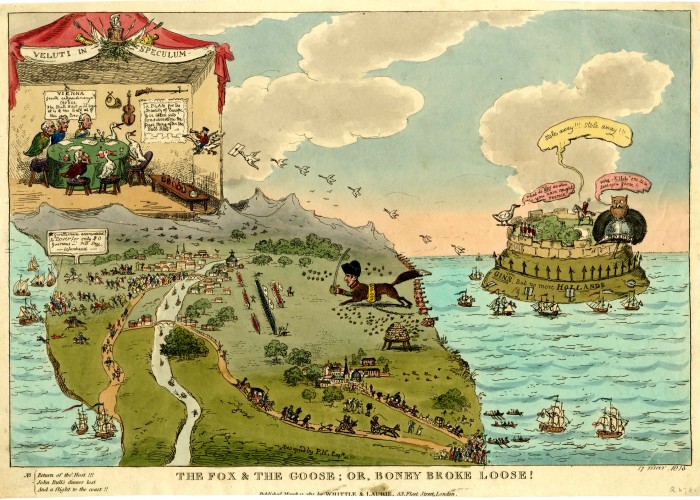The Fox and the Goose, or Boney Broke Loose
This cartoon, published in March 1815, shows Napoleon’s escape from Elba and return to France – the events that led directly to the Battle of Waterloo on 18 June 1815. Napoleon, here depicted as a fox, has broken out of the prison island of Elba (right) and is charging into France, spreading chaos. The leaders of Europe, drawn as birds, are startled at the Congress of Vienna (top left), and refugees are fleeing Paris
This satirical drawing, by the famous English cartoonist George Cruikshank, was published on March 17 1815, in London. Napoleon had escaped from his exile on the Mediterranean island of Elba just weeks before, and landed in southern France on 1 March. Ambassadors for the European rulers who had defeated Napoleon in 1814 were gathered at a congress in Vienna, deciding how to dismantle the French Empire. Napoleon’s return startled and horrified these statesmen, who declared Napoleon an “outlaw”, meaning anyone could legally kill him. King Louis XVIII, who had replaced Napoleon as ruler of France, and many other French aristocrats, fled to Britain, Spain or Germany fearing Napoleon’s revenge – all captured by Cruikshank’s art.
The cartoon is incredibly detailed, packed with symbolism and humour. Napoleon has literally “outfoxed” his enemies, but his vulpine form also suggests that he is untrustworthy and bloodthirsty. He carries a sword, treasure (400,000 gold coins), and is surrounded by bees – his royal symbol when he was Emperor. The ambassadors at the Congress of Vienna, meanwhile, are shown as geese, suggesting they are stupid and flighty. As foxes are notorious for killing birds, there is also a suggestion that Napoleon may wreak havoc on his enemies.
There is a wealth of other satirical detail, like the sign posted by (presumably British) sailors offering French refugees passage to Dover: “Only 20 guineas [very expensive] – NB. Pay beforehand”. On the empty cage of Elba, a small mounted figure shouts “Stole away! Stole away!”. This probably represents Colonel Neil Campbell, British Commissioner on Elba, who had been visiting Italy at the time of Napoleon’s flight. An owl, sitting on the helmet of Minerva (Roman goddess of wisdom) suggests that vermin (like foxes) ought to be killed – perhaps showing what Cruikshank thought should be done to Napoleon if he was captured a second time. This cartoon captures the chaos and confusion which consumed Europe in the months before the Battle of Waterloo.
-
Curatorial info
- Originating Museum: British Museum
- Accession Number: 1868,0808.8191
- Production Date: March 1815
- Creator: George Cruikshank
- Material: Hand colour etching on paper
- Creation Place: London
- Size: H 27.3 cm x W 39 cm
-
Use this image
You can download and use the high resolution image for use in a non-profit environment such as a school or college, but please take note of the license type and rights holder information below
- Rights Holder: Copyright The Trustees of the British Museum
- License Type: All Rights Reserved
Find it here
This object is in the collection of British Museum







